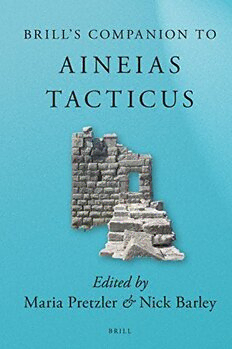
Brill’s Companion to Aineias Tacticus PDF
Preview Brill’s Companion to Aineias Tacticus
Brill’sCompaniontoAineiasTacticus Brill’s Companions in Classical Studies Thetitlespublishedinthisseriesarelistedatbrill.com/bccs Brill’s Companion to Aineias Tacticus Editedby MariaPretzler NickBarley leiden | boston Coverillustration:CitywallsofMessene,photobyMariaPretzler TheLibraryofCongressCataloging-in-PublicationDataisavailableonlineathttp://catalog.loc.gov lcrecordavailableathttp://lccn.loc.gov/2017037587 TypefacefortheLatin,Greek,andCyrillicscripts:“Brill”.Seeanddownload:brill.com/brill-typeface. issn1872-3357 isbn978-90-04-22351-6(hardback) isbn978-90-04-35285-8(e-book) Copyright2018byKoninklijkeBrillnv,Leiden,TheNetherlands. KoninklijkeBrillnvincorporatestheimprintsBrill,BrillHes&DeGraaf,BrillNijhoff,BrillRodopiand HoteiPublishing. Allrightsreserved.Nopartofthispublicationmaybereproduced,translated,storedinaretrievalsystem, ortransmittedinanyformorbyanymeans,electronic,mechanical,photocopying,recordingorotherwise, withoutpriorwrittenpermissionfromthepublisher. AuthorizationtophotocopyitemsforinternalorpersonaluseisgrantedbyKoninklijkeBrillnvprovided thattheappropriatefeesarepaiddirectlytoTheCopyrightClearanceCenter,222RosewoodDrive, Suite910,Danvers,ma01923,usa.Feesaresubjecttochange. Thisbookisprintedonacid-freepaperandproducedinasustainablemanner. Contents ListofFiguresandPhotos vii 1 Introduction 1 MariaPretzlerandNickBarley 2 ‘TheOtherAineias’ 14 DavidWhitehead 3 AineiastheAuthor:Who,WhereandWhen? 33 RobinLaneFox 4 AineiasTacticusinHisIntellectualContext 49 D.GrahamJ.Shipley 5 AineiasandHistory:ThePurposeandContextofHistoricalNarrative inthePoliorketika 68 MariaPretzler 6 CreatingKoine:AineiasTacticusintheHistoryoftheGreek Language 96 JoséVelaTejada 7 WritingandOtherFormsofCommunicationinAineias’ Poliorketika 123 PeterLiddel 8 ThePolisFallingApart:AineiasTacticusandStasis 146 MariaPretzler 9 GreekPoleisandWarfareintheFourthCenturybc:Aineias’ Poliorketika 166 MarcoBettalli 10 LightInfantryandLeadershipinAineias 182 NickBarley vi contents 11 MercenariesinAineiasTacticus 206 JamesRoy 12 RaidersfromtheSea:TheMaritimeContextofthePoliorketika 214 PhilipdeSouza 13 NotesfromHome:APerspectiveonFourth-CenturyDefencefrom ArkadianStymphalos 229 BenGourley 14 TechnologyinAineiasTacticus:SimpleandComplex 265 TraceyE.Rihll 15 TheReceptionofAineias’PoliorketikainByzantineMilitary Literature 290 PhilipRance Indexlocorum 375 Index 391 List of Figures and Photos Figures 0.1 PlacesandregionsmentionedinAineias’Poliorketika—seetableonpp.89– 93.Stymphalos,whichisnotmentioned,hasbeenaddedtothe map. viii 13.1 RegionalmapshowingStymphalosinrelationtootherancientsiteswith majorcentreshighlighted 236 13.2 Valleymapshowingpositionoftheancientsitewithneighbouringmodern villagesandancienttransportationroutesoutofthevalleytootherancient centres 237 13.3 Obliqueelevatedviewofvalleywithareaofancientsitedelineatedwith dottedline 242 13.4 Siteplan 244 13.5 Towersoneastwall,aerialview 246 13.6 ResistivityPhliousgatewithsurveyofcropmarkfeatures 249 13.7 Westgateresistivityplotshowingwallandgateonleftofimageandinternal citydivisionstotheright.Scaleisinmetres. 251 13.8 LocationofPheneosGatewithrespecttointernalheroshrineandfountain house 253 13.9 Reconstructionofwestwalltowerof4thcenturydate 256 13.10 Westwallartillerytower:plan 258 13.11 Westwallaerialphotoshowinglargeartillerytowersurroundingsmaller rectangulartower 259 13.12 Aerialviewofsouthacropoliswallwithhexagonaltowerandnearby sanctuaryonacropolisterrace 260 14.1 ReconstructionofAineias’anti-ladderdeviceafterGarlan(1974), figure2 276 14.2 ReconstructionofAineiasanti-ladderdevice.T.E.Rihll. 278 15.1 TheTransmissionofAineias’PoliorketikainLateAntiqueandByzantine MilitaryLiterature 359 Photos 14.1 LadderdepictedontheNereidmonument,Xantos390–380bc(British Museum)PhotographM.Pretzler. 273 14.2 RemainsofthewallsofHerakleiaonLatmos.PhotographT.E.Rihll. 277 figure 0.1 Aineias’World.PlacesandregionsmentionedinAineias’Poliorketika—seetableon pp.89–93.Stymphalos,whichisnotmentioned,hasbeenaddedtothemap. chapter 1 Introduction MariaPretzlerandNickBarley This volume examines a unique example of classical Greek Literature: the Poliorketika or How to Survive under Siege by Aineias ‘the Tactician’. Aineias’ solesurvivingworkshowsusanancientGreecefarfromthewell-documented affairsofAthensorthelegendarysocietyofSparta.Wearetakentoplaceswith small populations and modest resources which only experience large scale warfare at the whim of greater powers. Many of these smaller poleis would not have had much in the line of a grand military tradition or accumulated military experience, and in an emergency the right person for the job may simplybewhoevergottherefirst.Aineias’adviceisdirectedtoaGreecewhere survivalof familyandpoliswasbalancedonaspear-point,whereinnovation andflexibilityof doctrineandpersonnelwereparamount,andwhereraiders ontheveryedgeof territoryrepresentednotjustanarmedincursion,butan existentialthreat. ThePoliorketikadefiesgenreconventions,evenwithinthefieldof military writing,sinceitisamanualaboutsiegeswhichbarelytalksaboutsiegesaswe would usually understand the term, and which focuses on the one universal weaknessofanypolis,itspeople,aswellaspresentinguswithadazzlingarray of vignettes illustrating the everyday life of a fourth-century polis. Aineias’ perspectiveoftheGreekworlddoesnotmatchtheviewpointsweareusedto seeinginclassicalliterature,somethingemphasisedbythefactthatalthough itisaclassicalGreektext,itisnotwrittenintheusualclassical(Attic)Greek literarylanguage.Inshort,Aineias’Poliorketikaisanexceptionalworkwhich rewards repeated reading. It offers a perspective on the Greek world that, armed as we are with our knowledge of the other great writers of the time, maybeconsideredunusual,butwhich,oncloserinspection,revealsthelives of citizens of ‘everyday’ states in all their chaotic glory. Further revisiting of thetextraisesmanyquestionsandrevealsafrustratingdiscrepancybetween whatAineiasistellingusandwhatwewoulddearlyliketoknow,butintensive studyofthetextrevealsanauthorwithakeen,inquisitivemind,acuriosityfor innovation,anunsentimentalpragmatism,astutepsychologicalinsightanda greatgiftforobservation. Here is a classical author, a close contemporary of Xenophon, Plato and Isocrates,whoseemstobequitedeterminedtoremindusof‘theotherGreece’, © koninklijkebrillnv,leiden,2018 | doi:10.1163/9789004352858_002 2 pretzler and barley of lifeinthemany poleisbeyondthefocusof ourcanonicallyAtticauthors.1 Aineias’ perspective can offer insights into Greek lives and aspects of Greek culture we can only speculate about when we read the historical accounts by Thucydides or Xenophon: we rarely even get to wonder what it was like to live behind the city walls of a small town, hoping to avoid conquest and massacre,usingwhatwasathand,andrelyingonwhatthesmallcommunity couldmusterintermsofmanpower,resourcesandingenuity.Hereisadifferent voice,standingonitsownintermsofgenre,viewpointandapproach.Aineias supplies a human scale to the grand narrative of classical Greek history: he homesinontheall-too-humanfailuresandeverydayproblemsfoundinany community,andregardshisfellowGreekswithaneyebothsoberlypragmatic and attuned to what one might be able to ask of ‘normal’ people faced with real existential threats. Finally, and despite the serious subject matter, the text is simply great fun toread, rewarding newcomersand returningvisitors alikewithanentertaininginsightintothepsycheofaClassicalGreekcityand (someof)itspopulation;whilewewouldnotdaresayittohisface,theeditors findAineias’textcharminglyengaging,andfeelthathisworkisallthemore importantbecauseofthis. We know very little about the author of this unusual military work. The manuscript tradition identifies the work as “Aelian’s tactical treatise on how tosurviveundersiege”,withascribalnoteattheendof theworksuggesting that the name of the author is actually Aineias.2 A further hint is contained in the work itself, where the author uses the name ‘Aineias’ in his explana- tionof acomplexmethodtoencryptmessages.3Thedateof theworkhasto be determined from the historical episodes mentioned to illustrate Aineias’ advice:thosestorieswhichcanbedatedclusterinthe370sand360s,withthe latestepisodeprobablyin360bc.4Acompositionof theworkinthe350sbc thereforeseemsverylikely.Thiswasaveryturbulenttime,afterthefinalcol- lapseofthedominanceofAthensandSparta,andthefailureofThebestoassert lastinginfluenceoveraareaswellbeyonditsaccustomedsphereofinfluencein andaroundBoiotia;inMacedonia,Philipiihadstartedtobuildhisempire,but theimpactofMacedonianinfluenceonthesouthernmainlandofGreecewas notyetwidelyrecognised.Oldallianceshadbecomeobsolete,andformany, 1 E.g.Whitehead(1990)2–4,Hansen(2007). 2 Whitehead(1990)5–6. 3 Aineias 33.18, the sequence of letters is in turn based on a conjecture, Haase (1835), cf. Whitehead(1990)7–8. 4 Whitehead(1990)8–10,HunterandHandford(1927)xxxiv–xxxvii;latestepisodeprobably 24.3–14,IlioncapturedbyCharidemos.
